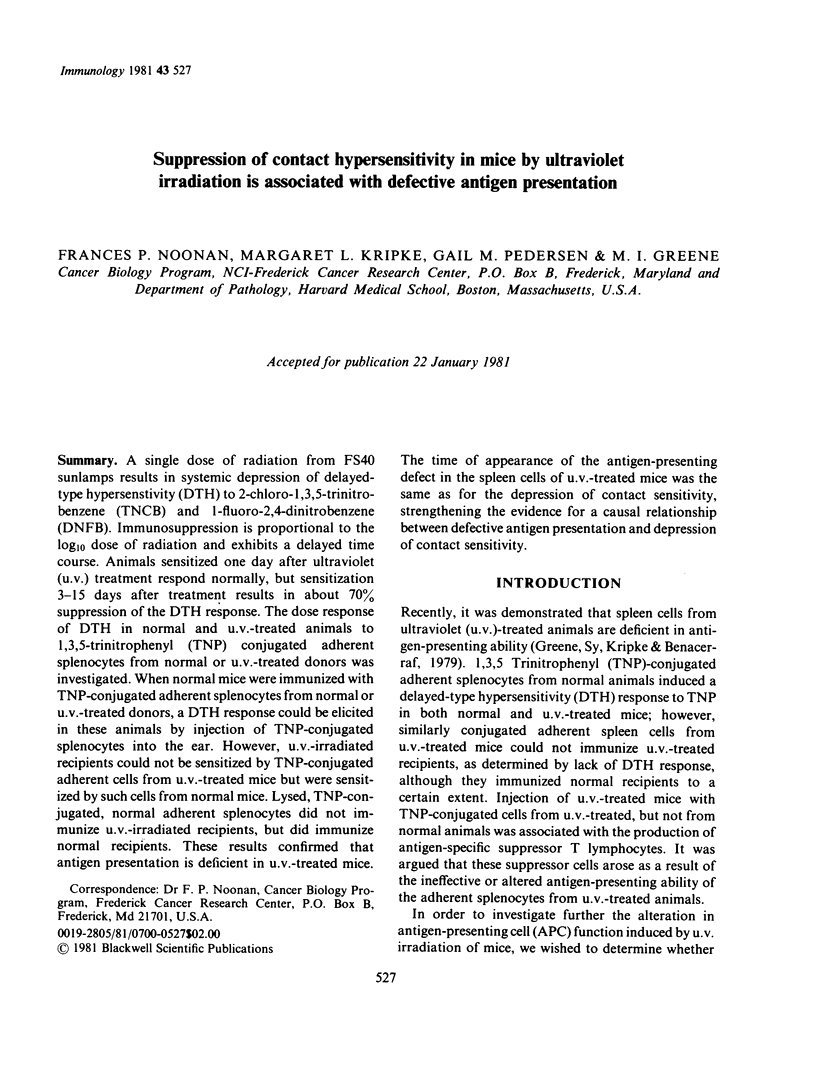Abstract
A single dose of radiation from FS40 sunlamps results in systemic depression of delayed-type hypersensitivity (DTH) to 2-chloro-1,3,5-trinitrobenzene (TNCB) and 1-fluoro-2,4-dinitrobenzene (DNFB). Immunosuppression is proportional to the log10 dose of radiation and exhibits a delayed time course. Animals sensitized one day after ultraviolet (u.v.) treatment respond normally, but sensitization 3-15 days after treatment results in about 70% suppression of the DTH response. The dose response of DTH in normal and u.v.-treated animals to 1,3,5-trinitrophenyl (TNP) conjugated adherent splenocytes from normal or u.v.-treated donors was investigated. When normal mice were immunized with TNP-conjugated adherent splenocytes from normal or u.v.-treated donors, a DTH response could be elicited in these animals by injection of TNP-conjugated splenocytes into the ear. However, u.v.-irradiated recipients could not be sensitized by TNP-conjugated adherent cells from u.v.-treated mice but were sensitized by such cells from normal mice. Lysed, TNP-conjugated, normal adherent splenocytes did not immunize u.v.-irradiated recipients, but did immunize normal recipients. These results confirmed that antigen presentation is deficient in u.v.-treated mice. The time of appearance of the antigen-presenting defect in the spleen cells of u.v.-treated mice was the same as for the depression of contact sensitivity, strengthening the evidence for a causal relationship between defective antigen presentation and depression of contact sensitivity.
Full text
PDF






Selected References
These references are in PubMed. This may not be the complete list of references from this article.
- Asherson G. L., Zembala M. Suppression of contact sensitivity by T cells in the mouse. I. Demonstration that suppressor cells act on the effector stage of contact sensitivity; and their induction following in vitro exposure to antigen. Proc R Soc Lond B Biol Sci. 1974 Nov 5;187(1088):329–348. doi: 10.1098/rspb.1974.0078. [DOI] [PubMed] [Google Scholar]
- DeFabo E. C., Kripke M. L. Dose-response characteristics of immunologic unresponsiveness to UV-induced tumors produced by UV irradiation of mice. Photochem Photobiol. 1979 Sep;30(3):385–390. doi: 10.1111/j.1751-1097.1979.tb07372.x. [DOI] [PubMed] [Google Scholar]
- Greene M. I., Sugimoto M., Benacerraf B. Mechanisms of regulation of cell-mediated immune responses. I. Effect of the route of immunization with TNP-coupled syngeneic cells on the induction and suppression of contact sensitivity to picryl chloride. J Immunol. 1978 May;120(5):1604–1611. [PubMed] [Google Scholar]
- Greene M. I., Sy M. S., Kripke M., Benacerraf B. Impairment of antigen-presenting cell function by ultraviolet radiation. Proc Natl Acad Sci U S A. 1979 Dec;76(12):6591–6595. doi: 10.1073/pnas.76.12.6591. [DOI] [PMC free article] [PubMed] [Google Scholar]
- Kripke M. L. Latency, histology, and antigenicity of tumors induced by ultraviolet light in three inbred mouse strains. Cancer Res. 1977 May;37(5):1395–1400. [PubMed] [Google Scholar]
- Kripke M. L., Lofgreen J. S., Beard J., Jessup J. M., Fisher M. S. In vivo immune responses of mice during carcinogenesis by ultraviolet irradiation. J Natl Cancer Inst. 1977 Oct;59(4):1227–1230. doi: 10.1093/jnci/59.4.1227. [DOI] [PubMed] [Google Scholar]
- Smith F. I., Miller J. F. Delayed-type hypersensitivity to allogeneic cells in mice. III. Sensitivity to cell-surface antigens coded by the major histocompatibility complex and by other genes. J Exp Med. 1979 Oct 1;150(4):965–976. doi: 10.1084/jem.150.4.965. [DOI] [PMC free article] [PubMed] [Google Scholar]
- Toews G. B., Bergstresser P. R., Streilein J. W. Epidermal Langerhans cell density determines whether contact hypersensitivity or unresponsiveness follows skin painting with DNFB. J Immunol. 1980 Jan;124(1):445–453. [PubMed] [Google Scholar]


